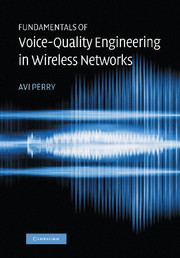Book contents
- Frontmatter
- Contents
- Preface
- List of abbreviations
- Introduction
- Part I Voice-quality foundations
- Part II Applications
- Part III Wireless architectures
- Part IV A network operator's guide for selecting, appraising, and testing a VQS
- Part V Managing the network
- 12 Trouble shooting and case studies
- Part VI Afterthoughts and some fresh ideas
- Part VII Recordings
- Glossary of common voice-quality systems terminology
- Brief summary of echo cancelation and VQS major standards
- Brief summary of key voice-quality assessment standards
- Bibliography
- Index
12 - Trouble shooting and case studies
Published online by Cambridge University Press: 24 May 2010
- Frontmatter
- Contents
- Preface
- List of abbreviations
- Introduction
- Part I Voice-quality foundations
- Part II Applications
- Part III Wireless architectures
- Part IV A network operator's guide for selecting, appraising, and testing a VQS
- Part V Managing the network
- 12 Trouble shooting and case studies
- Part VI Afterthoughts and some fresh ideas
- Part VII Recordings
- Glossary of common voice-quality systems terminology
- Brief summary of echo cancelation and VQS major standards
- Brief summary of key voice-quality assessment standards
- Bibliography
- Index
Summary
Introduction
This chapter presents an extensive account of conditions that must be accommodated for healthy voice communications to result. The presentation is carried out as if the reader is in charge of running a mobile-switching center where all equipment, including voice-quality assurance gear, has been operating satisfactorily up to that moment in time when the specific trouble at issue has been reported. The specific troubles are analyzed for root cause and remedial actions.
The chapter includes a list of 40 cases. Some of these cases are supported by example recordings (www.cambridge.org/9780521855952), which illustrate certain aspects of the case in more detail.
List of troubles
Just installed a new upgraded EC and there is echo
Probably one of the most common complaints: “I have just upgraded my network and installed stand-alone echo cancelers and voice-quality enhancement applications. Immediately after, customers from all over started complaining about echo. My older EC did not have all the bells and whistles, but was canceling the echo most of the time.”
A common root cause: the newly installed echo cancelers were mounted backwards. The receive and send port connections to the network were reversed. Echo returning from the PSTN enters the receive side instead of the send side (see Figure 12.1).
Just moved the stand-alone EC from the PSTN interface to the A-interface and there is echo
A common mistake: “I replaced the echo canceler to PSTN connection with a connection to the TRAU. I followed the same procedure and steps I had gone through when installing it on the PSTN side.”
- Type
- Chapter
- Information
- Fundamentals of Voice-Quality Engineering in Wireless Networks , pp. 261 - 286Publisher: Cambridge University PressPrint publication year: 2006



